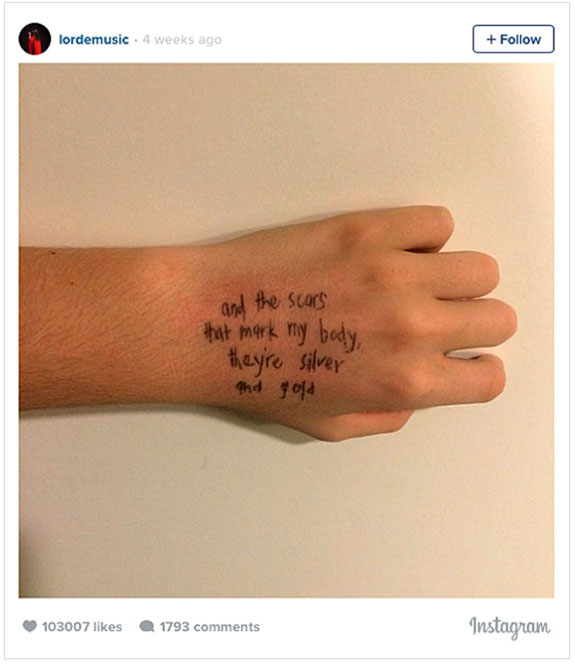Welcome to Music Friday when we bring you awesome songs with jewelry, gemstones or precious metals in the title or lyrics. Today, Lorde channels Hunger Games protagonist Katniss Everdeen in “Yellow Flicker Beat,” a dark jam that’s infused with references to gemstones and precious metals.
In the first verse, Lorde sings, “I’m a princess cut from marble, smoother than a storm / And the scars that mark my body, they’re silver and gold / My blood is a flood of rubies, precious stones / It keeps my veins hot, the fires found a home in me.”
“Yellow Flicker Beat” was released in 2014 as the lead single from the Lorde-curated soundtrack to The Hunger Games: Mockingjay — Part 1, which starred Academy Award-winning actress Jennifer Lawrence as Katniss Everdeen.
Lorde explained the inspiration behind “Yellow Flicker Beat” in an interview with radio station KROQ’s Kevin and Bean.
“I reread the books, and I just wanted to tap into everything that Katniss is feeling in that film,” she said. “I felt like Katniss was like, ‘OK, I’m taking names. I’m coming for blood. You don’t do these types of things to my friends and family and get away with it.’ I just wanted to make something kind of dark and haunting.”
Just before the song’s release, Lorde teased “Yellow Flicker Beat” on her Instagram by posting this photo of her hand marked with hand-written lyrics from the song.
On her own Tumblr, Lorde wrote at the time, “It’s my attempt at getting inside her head. I hope you like it.”
And a lot of music lovers did. The song was a huge hit for the New Zealand-born performer as it charted in 14 countries, including a #1 placement in her native country, #34 on the US Billboard Hot 100 and #21 on the Canadian Hot 100. It was nominated for Best Original Song at the 72nd Golden Globe Awards and Best Song at the 20th Critics' Choice Awards.
Lorde's performance video boasts 85.6 million views and the music video featuring clips from the movie has earned 18.6 million views. Kanye West remixed the song for the Hunger Games compilation album.
The 23-year-old singer-songwriter, who was born Ella Marija Lani Yelich-O’Connor, is clearly enamored with gemstones. In her Grammy Award-winning debut single, “Royals,” she opened with the line, “I’ve never seen a diamond in the flesh.”
The daughter of an award-winning poet, Lorde, endured the names "Dusty" and "Casper" as a child because of her light complexion.
She got her big break as a 12-year-old when Universal Music NZ executive Scott Maclachlan saw a video of her performing at an intermediate school talent show. She signed with the label one year later and reached #1 on the US Billboard Hot 100 as a 16-year-old with her song "Royals." With that feat, she became the youngest solo artist to write and perform a US chart-topper.
Please check out the video of Lorde performing “Yellow Flicker Beat.” The lyrics are below if you’d like to sing along...
"Yellow Flicker Beat"
Written by Ella Yelich-O'Connor and Joel Little. Performed by Lorde.
I'm a princess cut from marble, smoother than a storm
And the scars that mark my body, they're silver and gold
My blood is a flood of rubies, precious stones
It keeps my veins hot, the fire's found a home in me
I move through town, I'm quiet like a fight
And my necklace is of rope, I tie it and untie
And the people talk to me, but nothing ever hits home
People talk to me, and all the voices just burn holes
I'm done with it (ooh)
This is the start of how it all ends
They used to shout my name, now they whisper it
I'm speeding up and this is the red, orange, yellow flicker beat sparking up my heart
We're at the start, the colors disappear
I never watch the stars, there's so much down here
So I just try to keep up with the red, orange, yellow flicker beat sparking up my heart
I dream all year, but they're not the sweet kinds
And the shivers move down my shoulder blades in double time
And now people talk to me, I'm slipping out of reach now
People talk to me, and all their faces blur
But I got my fingers laced together and I made a little prison
And I'm locking up everyone who ever laid a finger on me
I'm done with it (ooh)
This is the start of how it all ends
They used to shout my name, now they whisper it
I'm speeding up and this is the red, orange, yellow flicker beat sparking up my heart
We're at the start, the colors disappear
I never watch the stars, there's so much down here
So I just try to keep up with the red, orange, yellow flicker beat sparking up my heart
And this is the red, orange, yellow flicker beat sparking up my heart
And this is the red, orange, yellow flicker beat-beat-beat-beat
Credits: Screen capture via YouTube.com. Screen capture via Instagram.com.









